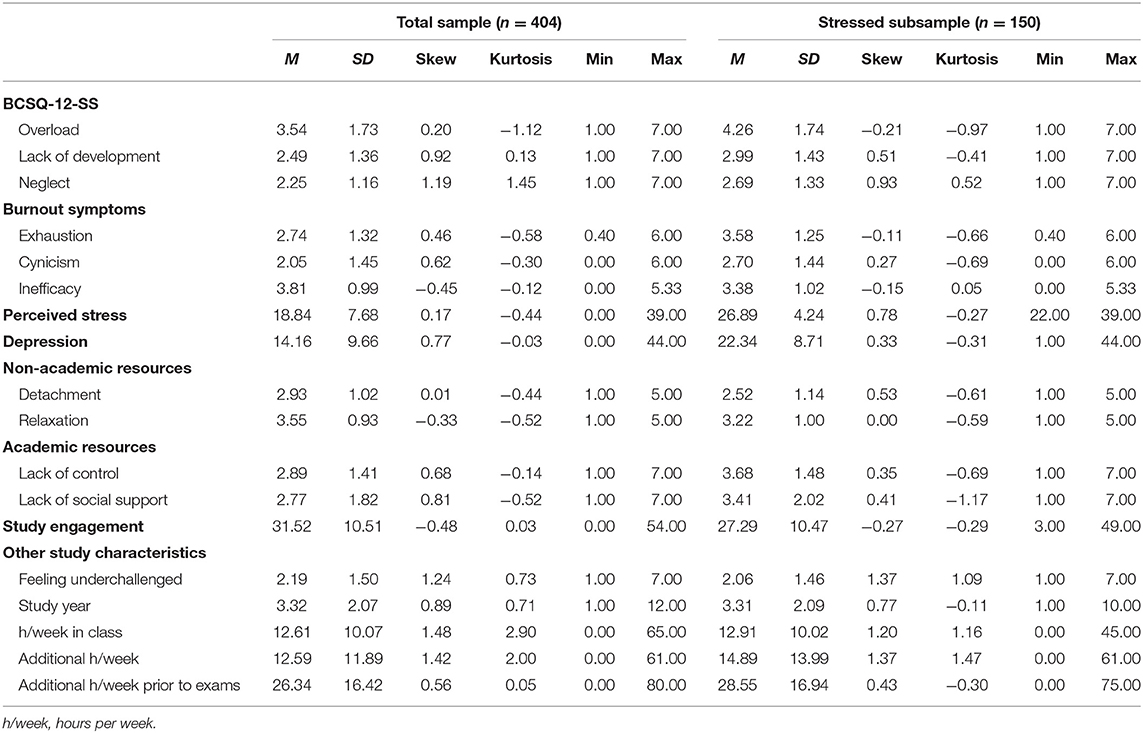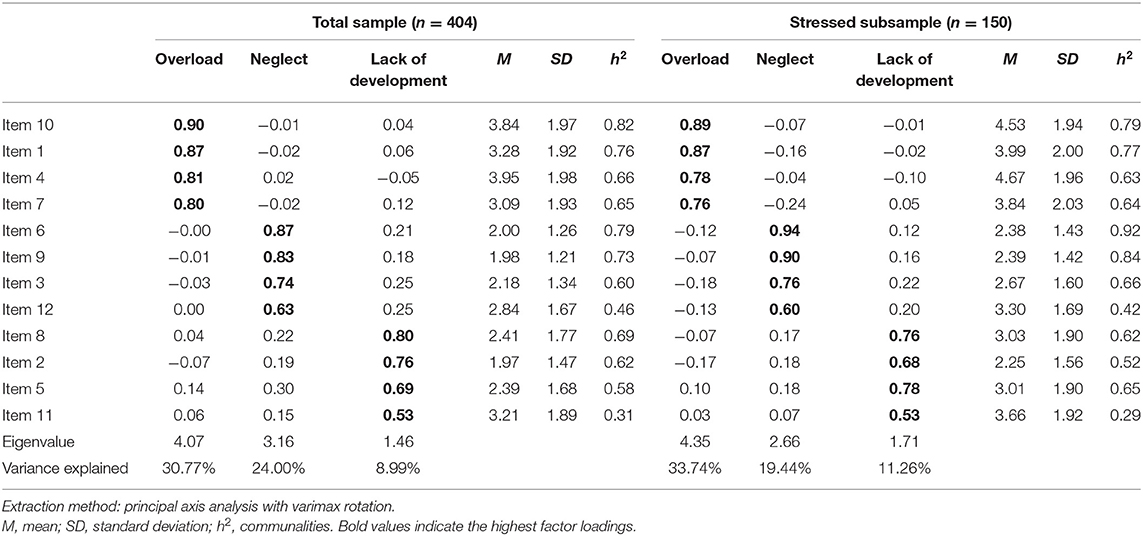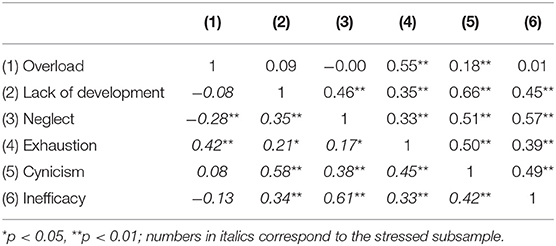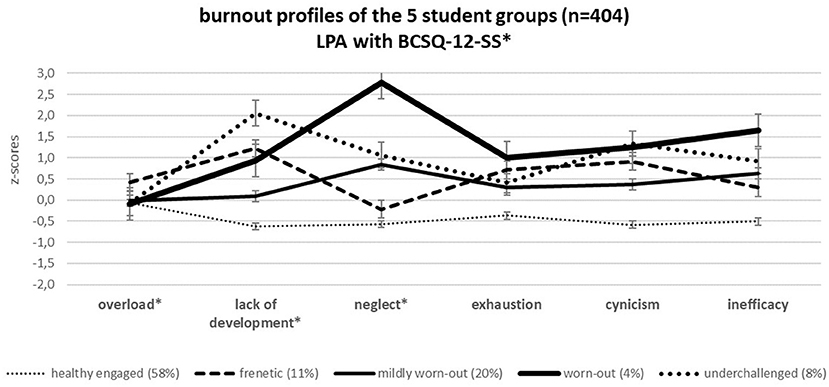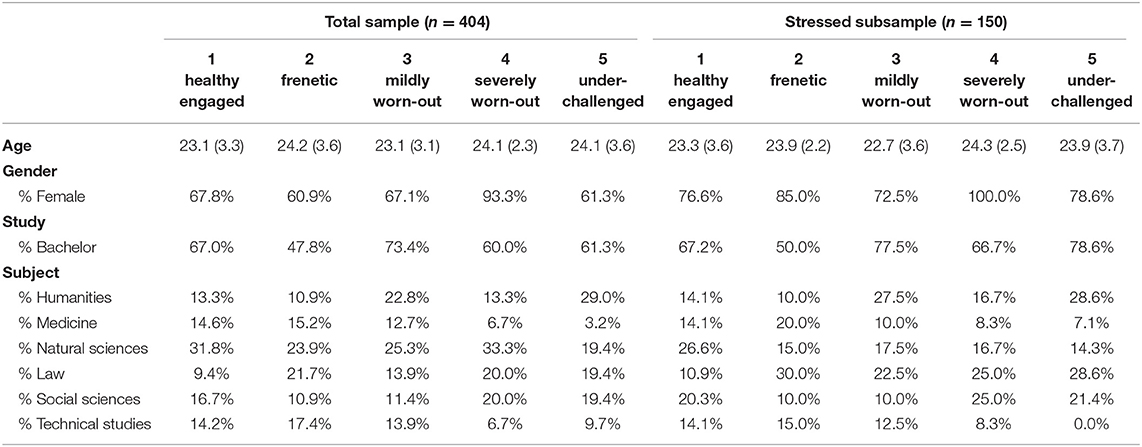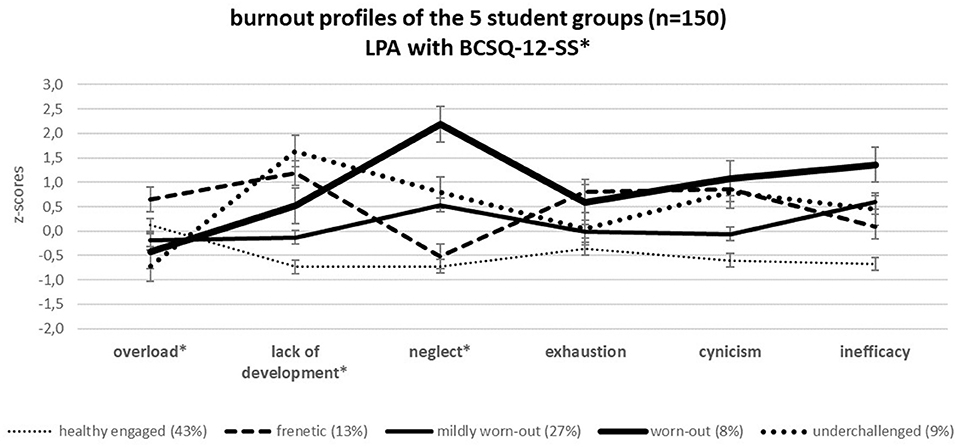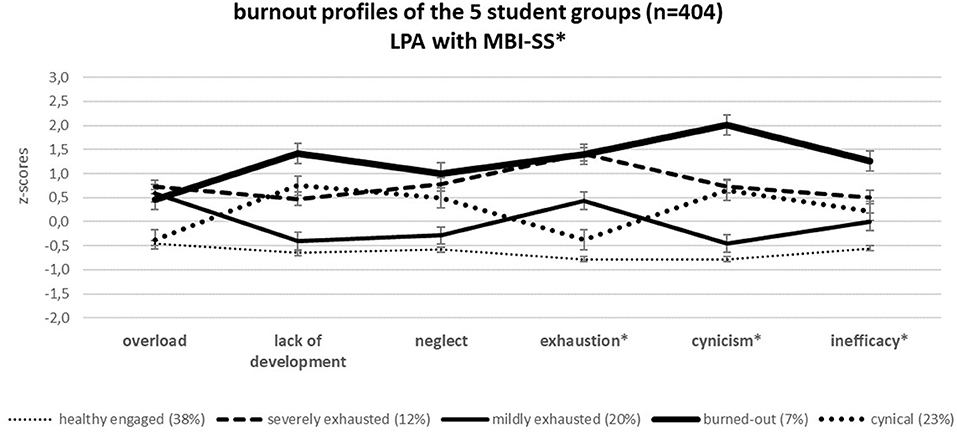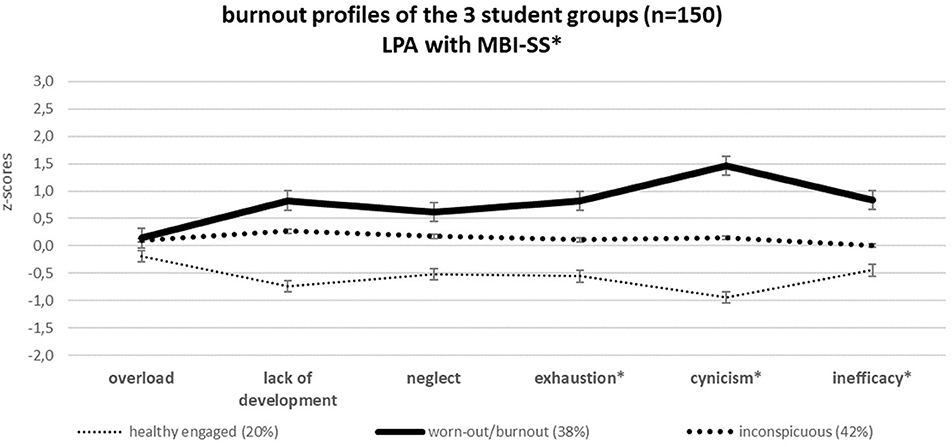- 1Department of Psychology, University of Graz, Graz, Austria
- 2Department of Psychology, University of Innsbruck, Innsbruck, Austria
Against the background of inconsistent findings regarding the symptomatology, etiology, and risk factors of burnout, Farber (1990) proposed three different burnout subtypes: frenetic, underchallenged, and worn-out. Montero-Marín et al. (2011b) expanded the typology to the academic context and developed the Burnout Clinical Subtypes Questionnaire–Student Survey (BCSQ-12-SS) to examine whether three burnout risk groups, that are in line with the typology, exist in university students as well. However, due to a moderate overlap between the BCSQ-12-SS subscales describing different risk groups, it has remained unclear whether three burnout risk groups can indeed be distinguished in university students. Moreover, the BCSQ-12-SS is currently not available in German, limiting the possibility to examine the typology in different student populations. Therefore, the aim of this study was to validate the BCSQ-12-SS for German speaking university students and to investigate whether three burnout risk groups—frenetic, underchallenged, and worn-out—can be identified in students using a person-oriented approach. Overall, 404 German speaking university students were recruited and filled in several online questionnaires, including the Maslach Burnout Inventory–Student Survey (MBI-SS) and the BCSQ-12-SS that was translated to German for the purpose of this study. The German BCSQ-12-SS had good psychometric properties. Latent profile analysis (LPA) with the BCSQ-12-SS distinguished three burnout risk groups: frenetic, underchallenged, and worn-out students, whereby mildly and severely worn-out students could be differentiated. Additionally, a group with healthy engaged students emerged. The groups differed in burnout symptoms, feelings of depression, workload, study engagement, and academic resources. Furthermore, the burnout risk groups could also be distinguished in a subsample of students (n = 150) who are particularly vulnerable to develop burnout because they were all moderately to highly stressed. LPA with the MBI-SS resulted in profiles similar to the healthy engaged, frenetic and severely worn-out profile. However, an underchallenged profile was only discovered with the BCSQ-12-SS, indicating that this questionnaire is particularly useful to detect an additional burnout risk group that has widely been overlooked in student burnout research so far. Taken together, this study observed three burnout risk groups in German speaking university students: frenetic, underchallenged, and worn-out.
Introduction
Within the previous years, the academic environment has become more stressful and competitive (Robotham and Julian, 2006; Bedewy and Gabriel, 2015). A large US survey revealed that 50% of undergraduate students experienced tremendous stress during the past year and 80% felt overwhelmed by all the things they had to do (American College Health Association, 2012). Likewise, a German study showed that today, students perceive a higher level of stress than working adults (Klein et al., 2016). Chronic stress has negative academic and health-related consequences for students, including poor academic performance, dropping out of one's studies, obesity, cardiovascular diseases, and the onset of mental health disorders (McEwen, 1998; Robotham and Julian, 2006; Klein et al., 2016).
Chronic stress also increases the likelihood of developing study-related burnout. Burnout is a chronic stress condition that develops as a reaction to prolonged demands (Maslach et al., 2001). While the exact definition of burnout is still being debated (Maslach et al., 2001; Kristensen et al., 2005; Shirom and Melamed, 2006; Demerouti and Bakker, 2008; Bianchi et al., 2015), like job burnout, student burnout is typically characterized by three main symptoms (Schaufeli et al., 2002): exhaustion due to high-perceived study demands, cynicism and a detached attitude toward one's studies, and feelings of inadequacy as a higher education student. However, the definition and symptoms of burnout are still controversially discussed, and the diagnosis is not included in clinical classification systems (see for a review Bianchi et al., 2015; Maslach and Leiter, 2016). In the International Statistical Classification of Diseases and Related Health Problems (ICD-10; World Health Organization, 1993), burnout is only classified in the additional category Z73 Problems related to life management difficulty, as a state of vital exhaustion (Z73.0 Burn-out). For the diagnosis of “clinical” burnout, Schaufeli et al. (2001) suggested that the ICD-10 criteria of work-related neurasthenia (F48.0) correspond to the psychiatric equivalent of burnout, while others proposed different cut-off criteria for the three dimensions of the Maslach Burnout Inventory–General Survey (MBI–GS; Maslach et al., 1996) to determine 'clinical burnout' in working adults (see for a review Kleijweg et al., 2013). For the Maslach Burnout Inventory–Student Survey (MBI–GS; Schaufeli et al., 2002), no agreed cut-off scores exist. Thus, as consistent diagnostic criteria and cut-off scores for clinical burnout are lacking, most current burnout research is conducted in samples of relatively healthy individuals, using a continuous instead of a categorical research approach, and predominantly focusing on identifying risk factors and risk groups (Worley et al., 2008). However, as several burnout symptom patterns (e.g., review Mäkikangas and Kinnunen, 2016; Salmela-Aro and Read, 2017; Sorkkila et al., 2017) and different longitudinal trajectories of the three main burnout symptoms have been observed across studies (e.g., Golembiewski et al., 1986; Leiter and Maslach, 1988; van Dierendonck et al., 2001), indicating that burnout is a multifaceted stress syndrome, it might be useful to differentiate several burnout risk groups. Approaches taking into account several burnout symptoms and characteristics simultaneously are recommended, because these might be associated with specific burnout risk groups (Mäkikangas and Kinnunen, 2016).
Over two decades ago, Farber (1990) proposed a burnout typology based on his clinical observations of working adults in helping and teaching professions. He suggested three burnout subtypes: frenetic, underchallenged, and worn-out. Recently, Montero-Marín et al. formalized the typology and expanded it to the general working population (Montero-Marín et al., 2009) as well as to university students (Montero-Marín et al., 2011b). According to their definition, the three subtypes are characterized as follows (Montero-Marín et al., 2009; Montero-Marín and García-Campayo, 2010). The frenetic subtype refers to ambitious, workaholic-like people who invest a substantial amount of time and effort into their job. They have a high need for achievement, tend to overload themselves with work, and increase their effort when faced with work-related stressors (active coping style). The underchallenged subtype characterizes people who lack challenges in their job. They experience work as boring, put just as much effort into a task as is necessary to fulfill it sufficiently, and wish to take on other, more gratifying jobs. The worn-out subtype refers to dispassionate people who feel desperate due to organizational rigidity and lack of resources at work (e.g., control, reward). Therefore, they neglect responsibilities, disengage from their job, and tend to resign (passive coping style).
The typology appears to be a promising approach to gain a better understanding of the multifaceted burnout syndrome. Note that Farber applied a qualitative social research approach when he derived the typology from in-depth interviews with teachers and psychotherapists. Montero-Marín and colleagues developed the Burnout Clinical Subtypes Questionnaire (BCSQ-36; Montero-Marín and García-Campayo, 2010; BCSQ-12; Montero-Marín et al., 2011c) and the Burnout Clinical Subtypes Questionnaire–Student Survey (BCSQ-12-SS; Montero-Marín et al., 2011b) to examine the typology empirically. They showed that working adults with frenetic characteristics worked usually more than 40 h per week. Men belonged more often to the underchallenged subtype, whereas employees who were working in an organization for more than 16 years belonged more often to the worn-out subtype (Montero-Marín et al., 2011a). Furthermore, the authors demonstrated that overloading oneself with work was primarily associated with exhaustion, lack of development with cynicism, and neglect—characterizing a passive coping style—with feelings of inefficacy (Montero-Marín and García-Campayo, 2010; Montero-Marín et al., 2012). These findings indicate that the proposed subtypes might have distinct burnout symptom profiles. Likewise, in dental students it was shown that frenetic students spent the most hours studying per week and they felt primarily exhausted due to overloading themselves with work. In contrast, students with underchallenged and worn-out characteristics felt mainly frustrated, with particularly low tension in underchallenged students and the least academic success in worn-out students (Montero-Marín et al., 2011b, 2014).
However, Montero-Marín and colleagues did not examine the burnout typology in 'clinical burnout' patients but in working adults and students (e.g., Montero-Marín and García-Campayo, 2010; Montero-Marín et al., 2011b,c, 2012, 2014). Consequently, the subtypes they identified may also be characterized as burnout risk groups rather than clinical burnout subtypes. Since burnout is not a diagnosis in clinical classification systems, exploring whether three distinct burnout risk groups exist, might nonetheless be one approach to apply and further evaluate the burnout typology (Worley et al., 2008). Yet, the previous studies examined students and employees with varying levels of perceived stress (e.g., Montero-Marín and García-Campayo, 2010; Montero-Marín et al., 2011b,c, 2012, 2014). Hence, it remained unclear whether three distinct burnout risk groups can also be distinguished in moderately to highly stressed individuals. After all, stress is a significant risk factor of burnout (Maslach et al., 2001; Schaufeli et al., 2002). Moreover, the various BCSQ-versions (Montero-Marín and García-Campayo, 2010; Montero-Marín et al., 2011b,c) are currently not available in German, but only in Spanish and English, limiting the possibility of evaluating the burnout typology in different populations. Finally, it has not been established whether the frenetic, underchallenged, and worn-out subtype can indeed be regarded as three distinct groups, because moderate correlations between the BCSQ-subscales describing different subtypes were observed (Montero-Marín and García-Campayo, 2010; Montero-Marín et al., 2011b,c, 2012), which indicates a certain overlap between the three groups.
Using a person-oriented approach to burnout, such as cluster analysis or latent profile analysis (LPA), is one way to examine how many burnout risk groups there might exist (Mäkikangas and Kinnunen, 2016). Previous studies used the three MBI subscales in clustering/LPA to explore whether subgroups with distinct symptom profiles can be distinguished (e.g., Mäkikangas and Kinnunen, 2016; Bauernhofer et al., 2018). The most common profiles that occurred in these studies were the burned-out and the engaged profile, including people with either high or low scores on all three burnout dimensions (exhaustion, cynicism, and feelings of inefficacy). Other common profiles were the exhausted/cynical profile and profiles where only one symptom was pronounced (exhausted, cynical, inefficacious). In the academic context, most previous studies focused on children (Salmela-Aro et al., 2016) and adolescents (Lee et al., 2010; Zhang et al., 2013; Sorkkila et al., 2017), while only one study explored burnout and engagement profiles in higher education students (Salmela-Aro and Read, 2017). This study discovered four different profiles: inefficacious, engaged, engaged-exhausted, and burned-out, with the latter two groups having some similarities with the frenetic and worn-out subtype (Montero-Marín et al., 2011b, 2014). However, a group with primarily bored and underchallenged students has to the best of our knowledge not been discovered with the MBI-SS (for a review see Mäkikangas and Kinnunen, 2016; Salmela-Aro and Read, 2017). Hence, the burnout typology described by Montero-Marín et al. (2011b) might be useful to identify an additional risk group that has mostly been overlooked in student burnout research. Moreover, as the main burnout symptoms are still controversially discussed (e.g., Bianchi et al., 2015; Maslach and Leiter, 2016), using the BCSQ-12-SS subscales (Montero-Marín et al., 2011b) in clustering/LPA, represents an alternative, non-symptom-based approach to examine burnout risk groups in university students.
Little is known to date to what extent the burnout subtypes/risk groups defined by Montero-Marín and García-Campayo (2010) and Montero-Marín et al. (2011b) may differ in feelings of depression, resources, and engagement. Specific group characteristics may help to expand our current understanding of the various pathways into student burnout and to develop subtype specific interventions (Farber, 1990). A vast amount of research has shown that burnout and depression overlap (see for a review Bianchi et al., 2015). The strongest overlap occurs between exhaustion and depression (Bianchi et al., 2015), but in the academic context, one study showed that students experiencing high inefficacy were the most depressed, irrespective of whether they were exhausted (Salmela-Aro and Read, 2017). Regarding resources, Farber (1990) suggested that merely the worn-out subtype lacks resources, but according to the job demand-resources (JD-R) model, lack of resources contributes fundamentally to burnout development (Bakker and Demerouti, 2017; Salmela-Aro and Read, 2017). Hence, the frenetic and the underchallenged subtype may lack resources as well, although they may lack different types of resources, including non-academic resources, such as the ability to unwind during leisure time (Bauernhofer et al., 2018). Furthermore, resources are associated with study engagement (Salmela-Aro and Read, 2017), which is a pleasurable, fulfilling state of mind, characterized by vigor, dedication, and absorption (Schaufeli et al., 2002). Engagement is considered the opposite of burnout, but it might only be reduced in underchallenged and worn-out students, because according to Farber (1990), frenetic people are over-engaged to their work.
Taken together, this study had several aims. First, to validate the BCSQ-12-SS for German speaking university students. Second, to investigate whether three distinct burnout risk groups—frenetic, underchallenged, and worn-out— can be identified in university students using a person-oriented approach and the BCSQ-12-SS and MBI-SS, respectively. Third, to examine whether three distinct risk groups can also be distinguished in students experiencing moderate to high levels of stress, because these students are particularly vulnerable to develop burnout. Finally, to investigate whether the different risk groups have distinct burnout symptom profiles and whether they differ in perceived stress, feelings of depression, recovery during leisure time, academic resources, and other study characteristics, including workload and study engagement.
Materials and Methods
Participants and Procedure
All students of the University of Graz (Austria) were invited to an online survey. The link to the survey was distributed via the university's official student mailing list and via social media. Additionally, flyers were dispensed across the university campus. Data were gathered in the final 2 weeks of the study year. Participation was voluntary and there was no financial compensation. Informed consent was obtained from all students prior to participation. The study was in accordance with the 1964 Declaration of Helsinki and was approved by the authorized ethics committee.
Overall, 509 students participated in the study. Non-native German speakers (n = 3) and students who dropped out of the survey (n = 102) were excluded from further analysis (non-completers). The final sample comprised of 404 students (completers). Of this total sample, a subsample of 150 students experiencing moderate to high levels of stress was selected to additionally explore whether distinct burnout risk groups can also be distinguished in stressed students, because these students are particularly vulnerable to develop burnout (Schaufeli et al., 2002). The subsample scored ≥22 in the German Perceived Stress Scale (PSS-10; Klein et al., 2016), which is one standard deviation above the population mean of university students (Roberti et al., 2006; Klein et al., 2016). This cut-off score has also been used in previous studies for the selection of stressed individuals in German populations (e.g., Ebert et al., 2016a,b; Heber et al., 2016) and was found to be indicative of moderate (Roberti et al., 2006) to high levels (Heber et al., 2017) of stress.
In the entire sample (n = 404; 67% women), students were between 18 and 35 years old (M = 23.34, SD = 3.33) and on average in the third year of their studies (M = 3.32, SD = 3.07); 65% were bachelor students, 35% were master students. The students were from various subjects and faculties, including natural sciences (29%), humanities (16%), social sciences (15%), technical studies (14%), medicine (13%), and law (13%). Comparisons of completers (n = 404) and non-completers (n = 105) showed that completers had higher study engagement [t(507) = −3.04, p = 0.002; completers: M = 31.52, SD = 10.51, non-completers: M = 28.00, SD = 10.79]. No other differences between completers and non-completers were found. The stressed subsample (n = 150; 79% women) comprised of students aged 18 to 34 (M = 23.34, SD = 3.32). On average, they were in their third study year (M = 3.31, SD = 2.09); 69% were bachelor students, 31% were master students. Faculty distribution in the subsample was as follows: natural sciences (21%), humanities (19%), law (19%), social sciences (17%), medicine (13%), and technical studies (12%).
Measures
Burnout Characteristics
Characteristics of the proposed burnout subtypes/risk groups were assessed with the BCSQ-12-SS (Montero-Marín et al., 2011b). It consists of three subscales; each subscale captures one subtype/risk group. The overload subscale characterizes the frenetic subtype/risk group (“I neglect my personal life to pursue great accomplishments in studying.”), the lack of development subscale refers to the underchallenged subtype/risk group (“I would like to study something else that would be more challenging to my abilities.”), and the neglect subscale describes the worn-out subtype/risk group (“When the results of my studies are not good at all, I stop making an effort.”) (4 items each). Answers are given on a 7-point rating scale ranging from 1 (completely disagree) to 7 (completely agree). Results are presented as scalar scores. As no German version of the BCSQ-12-SS existed, the English version was translated into German for the purpose of this study. The items were translated by the first author of this study and translated back into English by a native English speaker who is also fluent in German. Linguistic discrepancies to the original version were discussed and adapted when necessary. Prior to the present study, the German BCSQ-12-SS was pre-tested in a small student sample to test for comprehensibility and unambiguousness of the wording. The final version of the German BCSQ-12-SS can be found in the Supplementary Table 1. In the entire sample, internal consistencies of the subscales were α = 0.91 (overload), α = 0.81 (lack of development), and α = 0.86 (neglect). In the highly stressed subsample, internal consistencies were α = 0.90 (overload), α = 0.79 (lack of development), and α = 0.89 (neglect).
Burnout Symptoms
The German MBI-SS (Gumz et al., 2013) was used. The exhaustion subscale consists of five items (“I feel emotionally drained by my studies.”), the cynicism subscale of four items (“I doubt the significance of my studies.”), and the efficacy subscale of six items (“I can effectively solve the problems that arise in my studies”). The items are answered on a 7-point frequency rating scale ranging from 0 (never) to 6 (daily). Answers to the efficacy subscale were reversed coded, so that high scores indicate high feelings of inefficacy. In the entire sample, internal consistencies of the subscales were α = 0.86 (exhaustion), α = 0.84 (cynicism), and α = 0.79 (inefficacy). In the highly stressed subsample, internal consistencies were α = 0.84 (exhaustion), α = 0.81 (cynicism), and α = 0.78 (inefficacy).
Perceived Stress
The German PSS-10 (Klein et al., 2016) was used. The PSS-10 is based on Lazarus' theory of stress appraisal (Lazarus and Folkman, 1984) and measures the degree to which a person perceived his/her live as unpredictable, uncontrollable, and overloading during the past month. It is sensitive to chronic stress arising from various life circumstances, including academic stressors. The PSS-10 is not a measure of psychiatric symptomatology, but instead can be used to determine those who are at risk for clinical psychiatric disorders (Roberti et al., 2006). The scale has ten items that are answered on a 5-point frequency rating scale ranging from 0 (never) to 4 (very often). Internal consistency of the scale was α = 0.88 in the entire sample and α = 0.63 in the highly stressed subsample, respectively.
Depressive Symptoms
The short version of the German Center for Epidemiologic Studies-Depression Scale (CES-D; Hautzinger and Bailer, 1993) was used. It consists of 15 Likert-scaled items and measures how often one experienced depressive symptoms in the past 7 days (0 = <1 day/never or seldom, 1 = 1–2 days/sometimes, 2 = 3–4 days/often, 3 = 5–7 days/mostly or the whole time). Internal consistency of the CES-D was α = 0.92 in the entire sample and α = 0.89 in the highly stressed subsample, respectively.
Recovery
Two subscales of the Recovery Experience Questionnaire (REQ; Sonnentag and Fritz, 2007), detachment and relaxation, were used to assess recovery during leisure time (4 items each). The items of the detachment subscale were adapted for the university context (“At the end of the day, I forget about my studies.”). The items of the relaxation subscale were kept in its original form (“At the end of the day, I do relaxing things.”). The REQ has a 5-point answering scale ranging from 1 (I do not agree at all) to 5 (I fully agree). In the entire sample, internal consistencies of the subscales were α = 0.89 (detachment) and α = 0.87 (relaxation). In the highly stressed subsample, internal consistencies were α = 0.91 (detachment) and α = 0.87 (relaxation).
Academic Resources
Two types of academic resources were assessed: perceived control over one's study progress and social support at the university (4 items each). The items were similar to the items used in previous research (Jacobs and Dodd, 2003; Montero-Marín and García-Campayo, 2010) but the wording was adapted to the university context (control: “I feel that my academic success is beyond my control”; social support: “I know too few people at my university who I can ask for advice when I have difficulties in my studies”). The items had a 7-point answering scale ranging from 1 (completely disagree) to 7 (completely agree), and they were reversed coded that high scores indicated high control and high social support, respectively. In the entire sample, internal consistencies of the subscales were α = 0.81 (control) and α = 0.93 (social support). In the highly stressed subsample, internal consistencies were α = 0.79 (control) and α = 0.93 (social support).
Study Engagement
The short version of the German Utrecht Work Engagement Scale– Student Survey (UWES-SS; Schaufeli and Bakker, 2003) was used. It consists of three subscales, vigor (“When I am doing my work as a student, I feel bursting with energy”), dedication (“I am enthusiastic about my studies”), and absorption (“When I am studying, I forget everything else around me.”). Each subscale has three items that are answered on a 7-point frequency rating scale ranging from 0 (never) to 6 (daily). A sum score of the three subscales was built representing the overall level of study engagement. Internal consistency of the UWES-SS was α = 0.92 in the entire sample and α = 0.91 in the highly stressed subsample, respectively.
Other Study Characteristics
The students indicated: subject, bachelor/master, and weekly academic workload. With regard to workload, they reported how many hours per week they spent on average in courses during the last year and how much time they spent additionally on learning and preparing course work each week. Additional workload was reported separately for less stressful weeks during the semester and for more stressful weeks prior to exams. To assess whether the students felt underchallenged in their studies, one additional item was included (“I wish my studies were more challenging.”), with a 7-point answering scale ranging from 1 (completely disagree) to 7 (completely agree). The item was included in addition to the corresponding BCSQ-12-SS subscale, because lack of development might not just be indicative of bored and underchallenged students. There might be other reasons as well why students feel lack of development in their studies (e.g., feeling overchallenged in one's studies, lack of control over one's study progress because of structural problems, such as limited places in courses). Hence, the additional item was included to examine whether some students experience indeed lack of development because they feel bored and underchallenged in their studies.
Statistical Analyses
All statistical analyses were conducted separately for the entire sample (n = 404) and for the stressed subsample (n = 150). Descriptive statistics of the metric study variables comprise of means, standard deviations, skew, kurtosis, minimum, and maximum scores. For the group variables, frequencies are reported. Comparisons between completers and non-completers were performed using independent sample t-tests and Pearson's chi-square tests.
Exploratory factor analysis (EFA) was conducted to test the factor structure of the German BCSQ-12-SS (principal axis method with varimax rotation). The number of factors was determined using Kaiser's criterion (eigenvalues > 1). The factor weight criterion (w > 0.50) was used to decide to which factor an item belonged (Fabrigar and Wegener, 2012). Reliability of the dimensions was assessed with Cronbach's α. Convergent validity was examined by means of Pearson correlations between the BCSQ-12-SS and the MBI-SS dimensions (Montero-Marín et al., 2011b).
To explore whether three distinct burnout risk groups—frenetic, underchallenged, and worn-out—can be distinguished in university students, latent profile analysis (LPA) with the three BCSQ-12-SS/MBI-SS subscales was performed in Mplus (Muthén and Muthén, 1998–2017). Prior to the analysis, the variables were standardized (z-score; M = 1, SD = 0). Then, a series of nested LPA models were compared for fit to determine the best number of classes. Since three to six different burnout profiles were most frequently found in prior research using a person-oriented approach (Mäkikangas and Kinnunen, 2016), models with up to six classes were tested. Model fit was assessed using the sample-size adjusted Bayesian Information Criterion (SABIC), entropy, the Voung-Lo-Mendell-Rubin Likelihood Ratio Test (VLMR-LRT), and the bootstrapped Lo-Mendell-Rubin test (BLRMT). Models with lower SABIC values and entropy values closer to 1 indicate a better fit. The VLMR-LRT and BLRMT compare the estimated model to a model with k-1 classes. A significant p-value indicates that the estimated model is superior to the k-1 model and should be preferred. As there is no common standard for the best fit criteria, typically a combination of fit criteria is used to determine the optimal number of classes. The final number of classes should also be determined based on the interpretability of the results (Tein et al., 2013).
A 3-step approach, which allows estimating the optimal number of classes and estimating the auxiliary variables at the same time (Asparouhov and Muthén, 2014), was used to examine how the classes differed in burnout symptoms/characteristics, perceived stress, depression, recovery during leisure time, academic resources, and additional study-related and sociodemographic characteristics (auxiliary variables). Pearson's chi-square tests were performed to explore how men/women and bachelor/master students were distributed among the classes. These statistical analyses were calculated in SPSS 25.
Results
Descriptive statistics of the metric study variables are presented in Table 1.
Psychometric Properties of the German BCSQ-12-SS
In the entire sample, requirements to conduct EFA were met. All items correlated significantly with each other, the KMO index was 0.81, and Bartlett's test of sphericity was significant (χ2 = 2774.74, df = 66, p < 0.001). EFA resulted in an unforced three-factor solution with eigenvalues >1, explaining 63.76% of the total variance. The scree-plot confirmed this factor solution. Results of the EFA are summarized in Table 2. Pearson correlations between the BCSQ-12-SS and MBI-SS subscales are shown in Table 3.
Likewise, in the stressed subsample, requirements to conduct EFA were met. All items correlated significantly with each other, the KMO index was 0.78, and Bartlett's test of sphericity was significant (χ2 = 1114.81, df = 66, p < 0.001). The same unforced three-factor solution was found as in the entire sample, explaining 64.4% of the total variance. The scree-plot confirmed this factor solution. Results of the EFA are summarized in Table 2. Pearson correlations between the BCSQ-12-SS and MBI-SS subscales are shown in Table 3.
LPA With the BCSQ-12-SS in the Entire Sample
The fit statistics for the different number of latent classes are shown in Table 4. None of the models was clearly superior to the others. The 2-class and 4-class solution fitted best according to the VLMR-LRT, the BLRT did not differentiate between the models. The SABIC value was lowest in the 6-class solution. The entropy value was highest in the 3-class solution, but the entropy value in the 5-class solution was almost equally high. As none of the models fitted clearly the best, the final number of classes was determined based on the interpretability of the results (Tein et al., 2013). We decided that the 5-class solution would be most appropriate, because in the 2-class, 3-class, and 4-class solution, meaningful groups were missing. In the 6-class solution, a group with average scores on all three BCSQ-12-SS dimensions emerged (inconspicuous profile); it was similar to another group with low burnout symptoms and did therefore not deliver any additional information. For the group description, both their BCSQ-12-SS and the MBI profile were considered (Table 5, Figure 1).
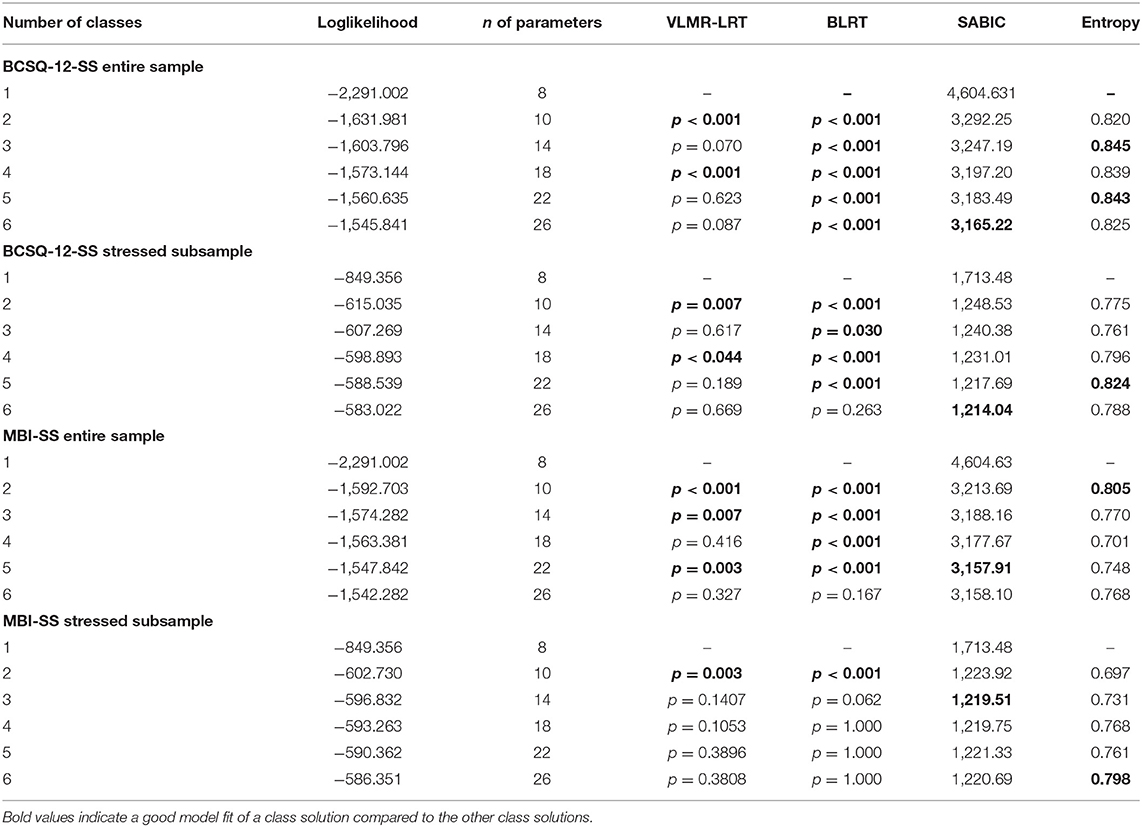
Table 4. Fit statistics of the LPA with the BCSQ-12-SS/MBI-SS in the entire sample and in the stressed subsample.
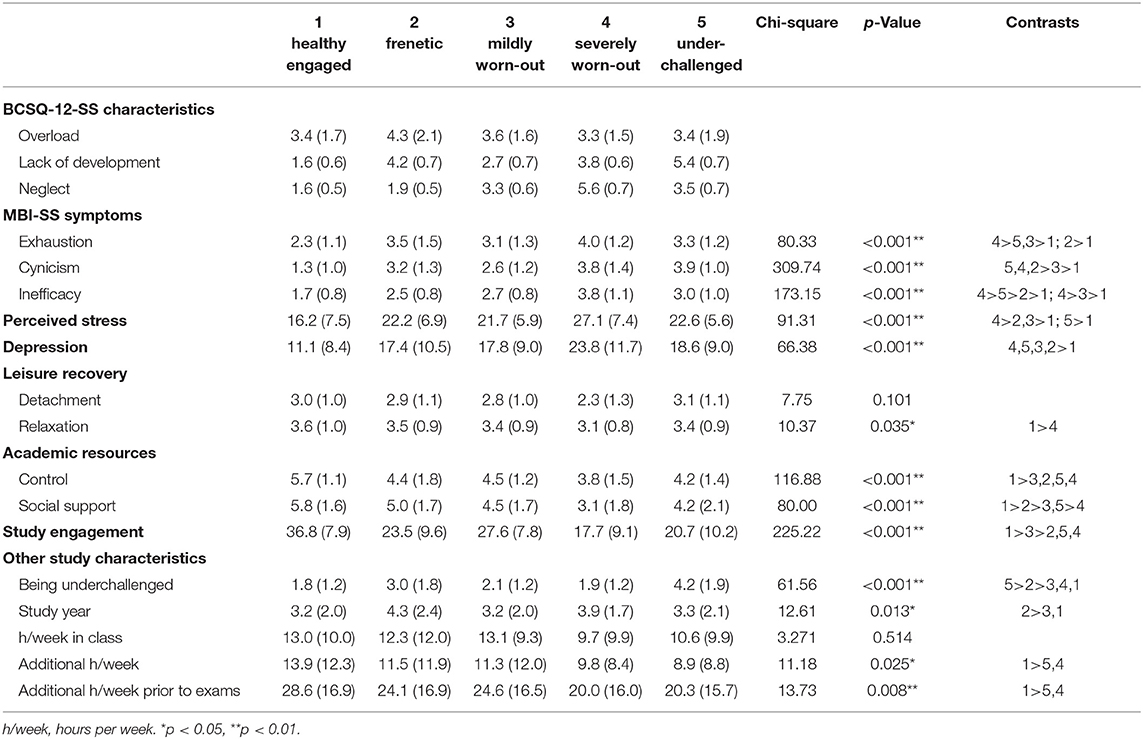
Table 5. Burnout, stress, and study characteristics of the five BCSQ-12-SS classes in the entire sample.
Healthy engaged students were the largest group (58%). These students did not show any BCSQ-12-SS characteristics and they had a healthy burnout profile, with low scores on all three burnout symptoms. The other four groups resembled the burnout typology described by Montero-Marín et al. (2011b), although two groups of the worn-out subtype could be distinguished. Additionally, the groups had distinct MBI profiles.
Frenetic students (11%) scored moderately on overload and high on lack of development. Their symptom profile was characterized by moderate to high exhaustion, moderate to high cynicism, and some feelings of inefficacy. Mildly worn-out students (20%) had high scores on neglect. Additionally, all three burnout symptoms were elevated, whereby feelings of inefficacy were the most pronounced. Severely worn-out students (4%) had high scores on lack of development and extremely high scores on neglect, which was as their most pronounced feature. Their burnout profile showed a full-blown burnout symptomatology, whereby feelings of inefficacy were also the most pronounced. Finally, underchallenged students (8%) had also high scores on neglect, but their most pronounced feature was extremely high lack of development. Their burnout profile was characterized by high cynicism and feelings of inefficacy; exhaustion was merely elevated.
The five clusters differed in their level of perceived stress and feelings of depression. Severely worn-out students felt the most stressed and depressed, followed by underchallenged, frenetic, and mildly worn-out students. Healthy engaged students had the lowest scores on both scales (Table 5).
Resources were highest in healthy engaged students and lowest in severely worn-out students. Healthy engaged students were better able to relax during leisure time than severely worn-out students. Additionally, both healthy engaged, underchallenged, and mildly worn-out students scored higher on detachment during leisure time than severely worn-out students, although the overall group difference did not reach statistical significance. With regard to academic resources, control over one's study progress was highest in healthy engaged students, while it was equally low in the other four groups. Social support at the university was highest in healthy engaged students, followed by frenetic students, mildly worn-out and underchallenged students, respectively. The lowest social support was reported by severely worn-out students (Table 5, Figure 2).
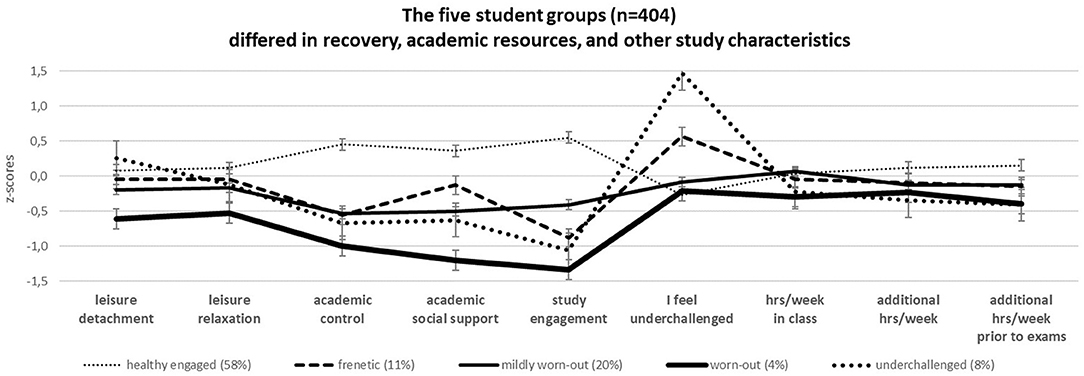
Figure 2. Recovery, academic resources, and other study characteristics of the five BCSQ-12-SS classes in the entire sample.
Study engagement was high in healthy engaged students, reduced in mildly worn-out students and low in the other three student groups. Underchallenged students wished more than all other students that their studies were more challenging, although frenetic students scored moderately on this item as well. Regarding the weekly hours spent in class, the five groups did not differ from each other. Yet, healthy engaged students indicated to invest more additional hours per week for learning and preparing course work than underchallenged and severely worn-out students (Table 5, Figure 2). Frenetic students were on average already in their fourth study year (Table 5) and more often in their master studies [ = 9.19, p = 0.057]. Table 6 shows the distribution of subjects within each group. No significant differences between the five student groups were observed [ = 23.47, p = 2.66].
Male and female students were equally distributed among the five groups [ = 6.02, p = 0.197], and there were no age differences [F(4, 399) = 1.84, p = 0.120; Table 6].
LPA With the BCSQ-12-SS in the Stressed Subsample
To examine whether three different burnout risk groups can also be distinguished in students experiencing moderate to high levels of stress, LPA with the three BCSQ-12-SS subscales was repeated in the stressed subsample. The fit statistics for the different number of latent classes are shown in Table 4. Like in the entire sample, none of the models was clearly superior. The 2-class and 4-class solution fitted best according to the VLMR-LRT, the BLRT did not differentiate between the models 2–5. The SABIC value was lowest in the 6-class solution. The entropy value was highest in the 5-class solution. Despite the small sample size in some classes, we decided that the 5-class solution would be most appropriate, because in the 2-class, 3-class, and 4-class solution, meaningful groups were missing. The five groups were very similar to the five groups detected in the entire sample (Table 7, Figure 3).
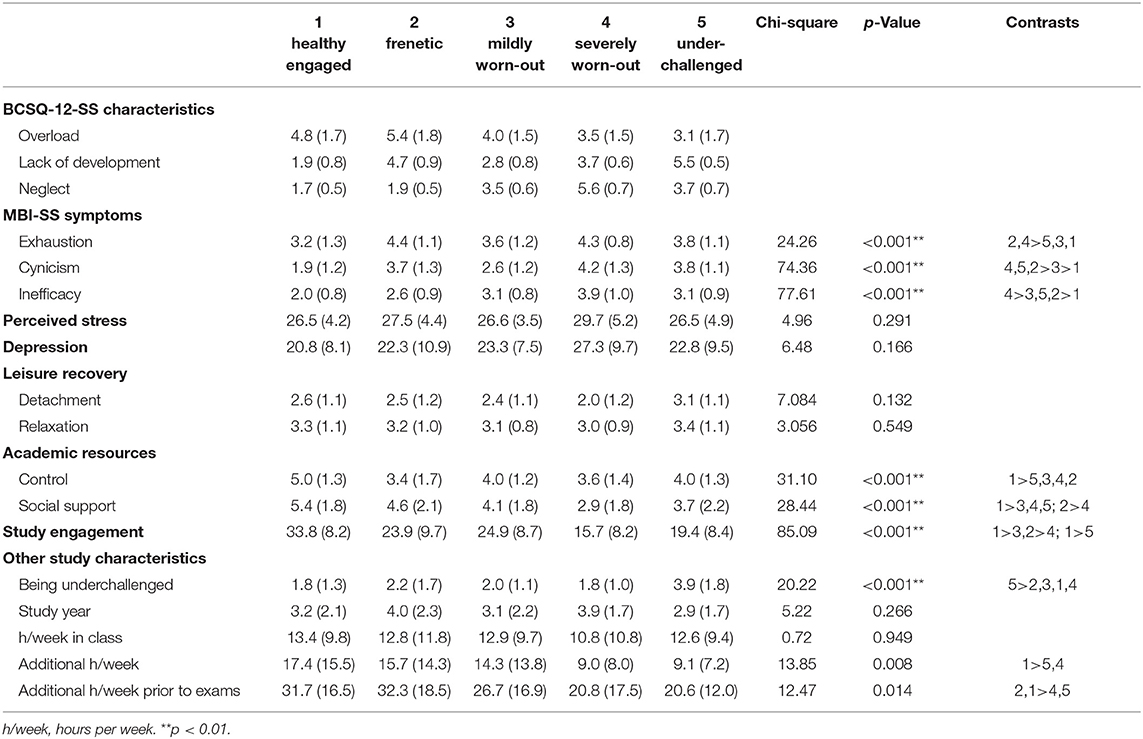
Table 7. Burnout, stress, and study characteristics of the five BCSQ-12-SS classes in the stressed subsample.
The largest class comprised of healthy engaged students (43%) who did not show any burnout characteristics (BCSQ-12-SS) or burnout symptoms (MBI-SS). Frenetic students (13%) scored significantly higher on overload in the subsample; the other profile characteristics did not meaningfully differ from the entire sample. High exhaustion and high cynicism were again the most pronounced burnout symptoms in this student group. Mildly worn-out students (27%) had moderate to high scores on neglect and feelings of inefficacy as their most pronounced features. Severely worn-out students (8%) had extremely high scores on neglect and a full-blown burnout symptomatology, whereby feelings of inefficacy were also the most pronounced. Finally, underchallenged students (9%) were primarily characterized by high lack of development, cynicism, and feelings of inefficacy.
In the subsample, the five student groups were equally stressed. The highest depression score was observed in worn-out students and the lowest score in healthy engaged students, although this difference did not reach statistical significance in the subsample. With regard to resources, the five groups did not differ in recovery during leisure time. Academic resources were very similar as in the entire sample (Table 7, Figure 4).
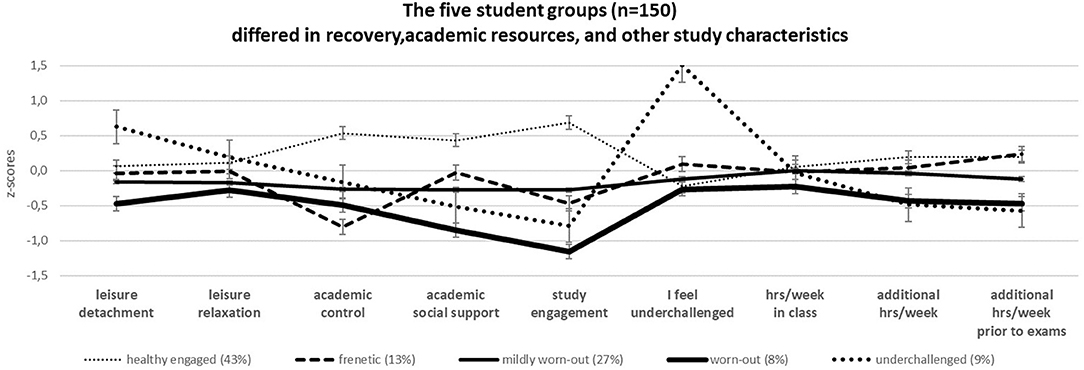
Figure 4. Recovery, academic resources, and other study characteristics of the five BCSQ-12-SS classes in the stressed subsample.
Study engagement was high in healthy engaged students, reduced in mildly worn-out and frenetic students, and low in underchallenged and worn-out students. Underchallenged students wished that their studies were more challenging. Regarding the weekly hours spent in class, the five clusters did not differ from each other. Yet, healthy engaged and frenetic students indicated to invest more additional hours per week for learning and preparing course work than underchallenged and severely worn-out students, although frenetic students reported to invest only more additional hours prior to exams (Table 7, Figure 4). Bachelor and master students were equally distributed among the five student groups [ = 5.42, p = 0.247]. Distribution of subjects within each group is shown in Table 6. Due to the small cluster sizes, a chi square test statistic was not calculated.
Male and female students were equally distributed among the five groups [ = 4.81, p = 0.308], and there were no age differences [F(4, 145) = 0.83, p = 0.509, Table 6].
LPA With the MBI-SS
To explore whether three distinct burnout risk groups, that are in line with the burnout typology described by Montero-Marín et al. (2011b), can also be found with the MBI-SS, LPA with the three MBI-SS subscales was performed. The fit statistics for the different number of latent classes are shown in Table 4. In the entire sample, the 2-class and 5-class model fitted the best. We decided that the 5-class solution was most appropriate, because in the 2-class solution, meaningful groups were missing. Moreover, the 5-class solution could be better compared to the 5-class solution detected with the BCSQ-12-SS. With the MBI-SS, healthy engaged students (38%) were clearly identified as well. Moreover, two groups of exhausted students could be distinguished: mildly exhausted (20%) and severely exhausted students (12%). The severely exhausted profile had some similarities to the frenetic profile detected with the BCSQ-12-SS (moderate to high scores on overload, lack of development, exhaustion, and cynicism). Furthermore, a group of burned-out students (7%) emerged. The symptom profile of this group, a full-blown burnout symptomatology, was the most severe; as was the symptom profile of severely worn-out students. However, burned-out students had rather moderate to high scores on all three BCSQ-12-SS dimensions and therefore not a typical worn-out profile, with neglect as most distinctive feature. Finally, a group with primarily cynical students emerged. The burnout profile of these students resembled the burnout profile of underchallenged students (cynicism and feelings of inefficacy as most pronounced symptoms), suggesting that underchallenged students might be hidden in the cynical profile. Yet, cynical students had less pronounced burnout symptoms, moderate scores on all three BCSQ-12-SS dimensions, and therefore not a typical underchallenged profile, with lack of development as most distinctive feature. Taken together, LPA with the MBI-SS was able to discover exhausted and burned-out students that were similar to the frenetic and worn-out subtype described by Montero-Marín et al. (2011b), whereas underchallenged students could not clearly be distinguished with the MBI-SS (Table 8, Figure 5).
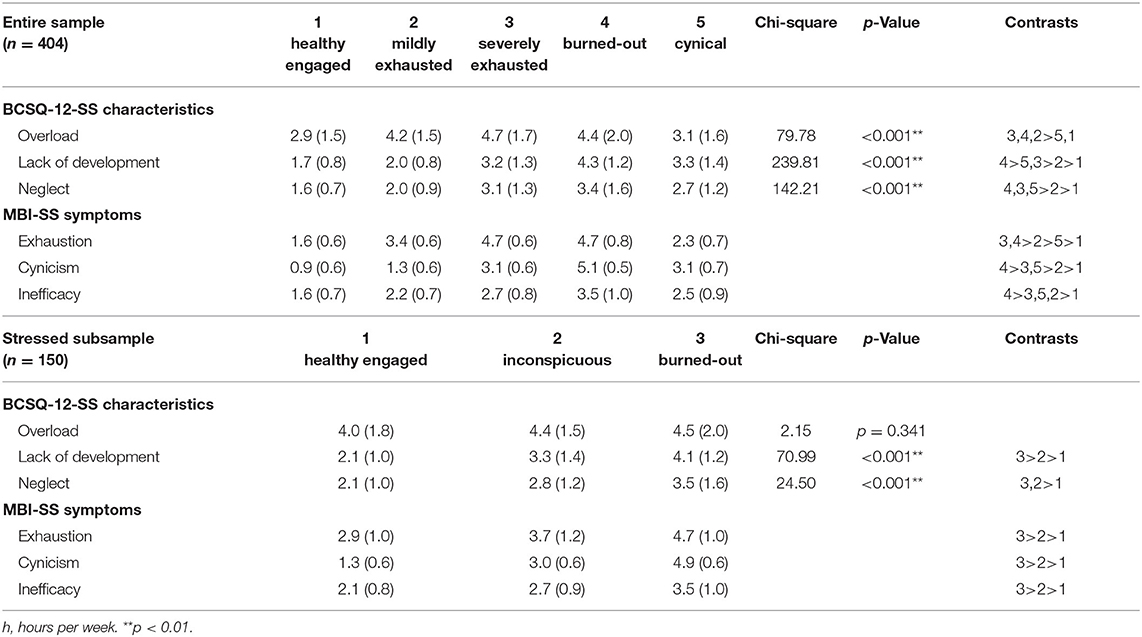
Table 8. Burnout characteristics of the five MBI-SS classes in the entire sample and in the stressed subsample.
In the subsample, LPA with the MBI-SS subscales was even less able to differentiate between the burnout risk groups described by Montero-Marín et al. (2011b). Only the 2-class and 3-class models seemed appropriate (Table 4), because in the 4-class, 5-class, and 6-class solution, classes with <10 individuals per class emerged. We decided that the 3-class solution would be most appropriate. The three classes were as follows: healthy engaged students (38%) had low scores on all burnout dimensions, burned-out students (20%) had high scores on all burnout dimension, and inconspicuous students (42%) had average to slightly elevated scores on all burnout dimensions. Hence, only the burned-out group resembling the worn-out subtype described by Montero-Marín et al. (2011b) could be distinguished in moderately to highly stressed students with the MBI-SS, while the frenetic and underchallenged subtype were not discovered (Table 8, Figure 6).
Discussion
This study pursued several aims. The primary aim was to validate the BCSQ-12-SS for German speaking university students in order to explore the burnout typology described by Montero-Marín and García-Campayo (2010) and Montero-Marín et al. (2011b) in a new student population. The secondary aim was to investigate whether three distinct burnout risk groups—frenetic, underchallenged, and worn-out—can be identified in university students using a person-oriented approach with the BCSQ-12-SS and MBI-SS, respectively. The third aim was to examine whether the three burnout risk groups can also be distinguished in students experiencing moderate to high levels of stress, because these students are particularly vulnerable to develop burnout (Schaufeli et al., 2002). Finally, this study examined whether the burnout risk groups have distinct burnout symptom profiles and whether they differ in perceived stress, feelings of depression, recovery during leisure time, academic resources, and other study characteristics, including workload and study engagement.
Validation of the German BCSQ-12-SS
The German BCSQ-12-SS had good psychometric properties. The three-factor structure of the original version was replicated (Montero-Marín et al., 2011b). Item loadings were high, and the communalities and internal consistencies of the three subscales were good. One exception was item 11 (“My studies do not provide me with opportunities to develop my abilities”), which had a communality <0.40, suggesting that future studies may search for possibilities to improve this item (Fabrigar and Wegener, 2012). Convergent validity of the German BCSQ-12-SS with the German MBI-SS was given. Yet, as in previous studies (Montero-Marín and García-Campayo, 2010; Montero-Marín et al., 2011b,c, 2012), the “lack of development” and “neglect” subscale of the BCSQ-12-SS were moderately correlated, indicating a certain overlap between the underchallenged and the worn-out risk group. Therefore, in the present study, LPA was additionally applied to examine whether three distinct burnout risk groups can be distinguished in university students.
Identification of the Burnout Risk Groups With the BCSQ-12-SS in the Entire Sample
LPA with the BCSQ-12-SS resulted in a 5-class solution. In line with the proposed burnout typology, a frenetic risk group (11%) emerged, although it differed to some extent from the corresponding profile described by Montero-Marín and García-Campayo (2010) and Montero-Marín et al. (2011b). Frenetic students reported to overload themselves with work and they were exhausted, which is in line with previous studies (Montero-Marín et al., 2011b, 2014). However, in the present research frenetic students were not over-engaged to their studies and overload was not their most characteristic BCSQ-12-SS feature; lack of development was even higher pronounced. Moreover, frenetic students were cynical, reported some feelings of inefficacy, and they lacked academic resources, in particular control over their study progress. High effort but low control over their study progress might explain why frenetic students experienced lack of academic development and why they were both exhausted and cynical (Jacobs and Dodd, 2003; Häusser et al., 2010). Due to frustration (Montero-Marín et al., 2014), they may have reduced their over-engagement and they may have felt some inefficacy because of their active but ineffective coping with the high study demands (Leiter, 1991). Hence, one explanation why the frenetic profile in this study differed from the corresponding profile described by Montero-Marín and García-Campayo (2010) and Montero-Marín et al. (2011b) might be that frenetic students had already progressed in the burnout cycle. According to Leiter and Maslach (1988), burnout development starts with exhaustion, followed by cynicism, until finally feelings of inefficacy occur. The burnout symptom profile of the frenetic students in this study corresponds well with that model. Besides, frenetic students were on average in their fourth study year and more frequently already in their master studies, indicating that they might have been struggling with high study demands for a prolonged period of time (Maslach et al., 2001; Schaufeli et al., 2002). Finally, the present study showed that resources were not only limited in the worn-out risk group (Montero-Marín and García-Campayo, 2010), but also in the frenetic risk group. Lack of resources contributes to burnout development (Bakker and Demerouti, 2017; Salmela-Aro and Read, 2017). However, frenetic students had still some social support at the university, which may also explain why they had not yet progressed to the final burnout stage, because social support is able to compensate for lack of control (Häusser et al., 2010).
This study yielded a worn-out risk group, and it was possible to differentiate between mildly worn-out (20%) and severely worn-out (4%) students. In line with the burnout typology described by Montero-Marín and García-Campayo (2010) and Montero-Marín et al. (2011b), the most characteristic feature of worn-out students was passive coping, indicated by a high score on neglect (BCSQ-12-SS). Moreover, feelings of inefficacy were the most pronounced burnout symptom in this group, and worn-out students lacked academic resources. Control over their study progress was equally low in mildly and severely worn-out students. Yet, severely worn-out students experienced even less social support at the university (Jacobs and Dodd, 2003) and they tended to have more difficulties to detach from their studies during leisure time. The lower level of resources might also explain why severely worn-out students were less engaged in their studies and had more severe burnout symptoms overall (Bakker and Demerouti, 2017; Salmela-Aro and Read, 2017; Bauernhofer et al., 2018). In fact, severely worn-out students had the least favorable profile of all students. They were completely disengaged from their studies, had a full-blown burnout symptomatology (Schaufeli et al., 2002; Montero-Marín et al., 2011b), and the highest level of depression. This finding is in line with Farber (1990) who described the worn-out subtype as deeply depressed.
This study brought forth an underchallenged burnout risk group (8%). The most characteristic feature of these students was lack of development (BCSQ-12-SS), which is in line with the subtype description of Montero-Marín and colleagues (Montero-Marín and García-Campayo, 2010; Montero-Marín et al., 2011b). Underchallenged students did not overload themselves with work and they wished more than all other students that their studies were more challenging, suggesting that they felt primarily bored. Boredom and lack of development cause frustration (Montero-Marín et al., 2014), which might explain why underchallenged students were highly cynical and disengaged from their studies. Additionally, they experienced some feelings of inefficacy and they were slightly exhausted, indicating that boredom may cause burnout symptoms as well (Reijseger et al., 2013). This fact has mostly been overlooked in prior student burnout research (Schaufeli et al., 2002; Lee et al., 2010; Zhang et al., 2013; Salmela-Aro et al., 2016; Salmela-Aro and Read, 2017; Sorkkila et al., 2017). Furthermore, underchallenged students had a rather passive coping style in the present study, indicated by elevated to high levels of neglect in the BCSQ-12-SS, and limited academic resources, which is both not in line with the burnout typology described by Montero-Marín and García-Campayo (2010) and Montero-Marín et al. (2011b). In fact, passive coping and resources were equally low in underchallenged and mildly worn-out students. Moreover, underchallenged students were as disengaged from their studies as severely worn-out students, suggesting that besides limited academic resources (Schaufeli et al., 2002; Bakker and Demerouti, 2017; Salmela-Aro and Read, 2017), boredom and frustration contribute to low study engagement as well (Pekrun et al., 2010; Tze et al., 2016). Taken together, by applying a person-oriented approach (Mäkikangas and Kinnunen, 2016) the present study could distinguish the underchallenged and worn-out risk group, although similarities in coping style, resources, and study engagement were observed. Hence, both burnout risk groups seem to overlap to a certain extent (Montero-Marín and García-Campayo, 2010; Montero-Marín et al., 2011b,c, 2012), but with underchallenged students facing study demands that are probably too low and worn-out students facing study demands that might probably be too high.
Finally, this study was able to distinguish healthy engaged students (58%) who did not show any burnout characteristics or symptoms. In fact, healthy engaged students had the most favorable profile, with sufficient recovery during leisure time and good academic resources. Moreover, they were engaged but not overcommitted to their studies, and they did not overload themselves with work. A healthy engaged profile is usually found in studies examining burnout profiles using a person-oriented approach (e.g., Mäkikangas and Kinnunen, 2016; Salmela-Aro and Read, 2017). Hence, compared to previous studies that examined the burnout typology (Montero-Marín et al., 2011b, 2014), the present study differentiated healthy engaged students from the proposed burnout risk groups (frenetic, underchallenged, and worn-out) and provided additionally information about the size of each group.
Identification of the Burnout Risk Groups With the BCSQ-12-SS in the Stressed Subsample
The different burnout risk groups were also observed in a subsample of students who were all moderately to highly stressed (frenetic: 13%, underchallenged: 9%, mildly worn-out: 27%, severely worn-out: 8%). Stress is a significant risk factor of burnout (Maslach et al., 2001; Schaufeli et al., 2002), but previous studies evaluating the burnout typology examined students with varying levels of stress (e.g., Montero-Marín et al., 2011b, 2014). Hence, it remained unclear whether the groups identified were indeed equally vulnerable to burnout. That particularly applies to the underchallenged risk group that experienced only low tension in a previous study (Montero-Marín et al., 2014). In contrast, in the present study, an underchallenged risk group was observed even in students who were moderately to highly stressed. Moreover, underchallenged students were equally stressed and depressed as frenetic and mildly worn-out students. These findings are in line with other studies demonstrating that enduring boredom is stressful (Pekrun et al., 2010) and can contribute to amotivation, burnout, and depression (Farmer and Sundberg, 1986; Reijseger et al., 2013).
Furthermore, the frenetic risk group discovered in the stressed subsample was more in line with the corresponding profile described by Montero-Marín and García-Campayo (2010) and Montero-Marín et al. (2011b). In the subsample, frenetic students scored high on overload (BCSQ-12-SS) and their study engagement and actual workload for learning and preparing course work were significantly higher than in underchallenged and severely worn-out students. The other profiles observed in the subsample did not meaningfully differ from the profiles observed in the entire sample. However, in the subsequent group comparisons, some differences occurred. The five student groups did not differ in recovery during leisure time, which is plausible because all students in the subsample were moderately to highly stressed. Moreover, the differences in the depression level did not reach statistical significance.
Taken together, in this study, distinct burnout risk groups were also observed in moderately to highly stressed students, including the underchallenged risk group that has often been overlooked in student burnout research so far (Schaufeli et al., 2002; Lee et al., 2010; Zhang et al., 2013; Salmela-Aro et al., 2016; Salmela-Aro and Read, 2017; Sorkkila et al., 2017). Additionally, even in the stressed subsample, the burnout risk groups could be distinguished from stressed but otherwise healthy engaged students. A healthy engaged group may have emerged in the stressed subsample because data was collected in the final 2 weeks of the study year. Hence, even healthy engaged students were moderately to highly stressed due to studying for their final exams. Yet, their stress level did not seem enduring, because burnout symptoms develop as a reaction to prolonged demands (Maslach et al., 2001), but contrary to the burnout risk groups, healthy engaged students did not have elevated burnout symptoms.
Identification of the Burnout Risk Groups With the MBI-SS
Not all proposed burnout risk groups (Montero-Marín et al., 2011b) were identified in LPA with the MBI-SS. In the stressed subsample, only a profile with similarities to the worn-out group was observed. In the entire sample, underchallenged students were not identified with the MBI-SS.
On the other hand, healthy engaged students could clearly be distinguished, irrespective of whether the BCSQ-12-SS or the MBI-SS was used. Moreover, the MBI-SS brought forth mildly exhausted and severely exhausted students, two typical burnout risk groups (Mäkikangas and Kinnunen, 2016) that seemed to represent students at different developmental stages in the burnout cycle. The severely exhausted profile was similar to the frenetic profile detected with the BCSQ-12-SS. Likewise, the burned-out profile detected with the MBI-SS, was similar to the severely worn-out profile detected with the BCSQ-12-SS. Both profiles represented a full-blown burnout symptomatology (Schaufeli et al., 2002), although burned-out students had rather moderate to high scores on all three BCSQ-12-SS dimensions and did not score as high on neglect. A group with mildly worn-out students was not found with the MBI-SS, but the mildly worn-out profile detected with the BCSQ-12-SS is in line with the inefficacious profile that was found in several other MBI studies (for a review see Mäkikangas and Kinnunen, 2016; Salmela-Aro and Read, 2017). Finally, LPA with the MBI-SS revealed a group with primarily cynical students in this study. The burnout profile of cynical students resembled the burnout profile of underchallenged students, but lack of development was not their most distinctive feature. Hence, bored and underchallenged students could not clearly be distinguished with the MBI-SS. Only the BCSQ-12-SS was able to identify this additional burnout risk group that has often been overlooked in student burnout research so far (Schaufeli et al., 2002; Lee et al., 2010; Zhang et al., 2013; Salmela-Aro et al., 2016; Salmela-Aro and Read, 2017; Sorkkila et al., 2017).
Outlook for Future Research
Future studies may examine whether a combined LPA with both the MBI-SS and the BCSQ-12-SS subscales may reveal underchallenged students that might be hidden in the cynical or in other MBI profiles. Moreover, future studies may seek to improve the lack of development subscale of the BCSQ-12-SS to be even more specific of underchallenged students. In the present study, frenetic and severely worn-out students had moderate to high scores on this subscale as well, indicating that there might be different reasons why students experience lack of development. However, this study showed that underchallenged students experienced lack of development because they felt bored and underchallenged in their studies. Compared to the other students, underchallenged students scored significantly higher on the item “I wish my studies were more challenging” that was included into the online survey in addition to the BCSQ-12-SS.
An interesting endeavor in future studies may also be to explore whether the frenetic, underchallenged, and worn-out profile might not represent distinct burnout risk groups but students at different stages in the burnout cycle, with the severely worn-out group representing the final stage. Farber (1990) acknowledged that people might transit from one subtype to another over time, and Montero-Marín et al. (2009) stated that the level of dedication to one's work might be the criterion that drives this transition. According to their theory, dedication to one's work is reflected in the way how individuals cope with work-related problems: the frenetic type copes with greater involvement in tasks and invests increasing effort; the underchallenged type copes with working superficially through indifference, detachment, and moderate involvement; and the worn-out type copes by neglecting responsibilities without putting involvement into a task, up to the point of giving up when faced with any difficulty. The level of dedication is captured by the overload and neglect subscale of the BCSQ-12-SS, representing two opposing ends of the same underlying construct (dedication). In the present study, high scores on overload were most characteristic of frenetic students, and high scores on neglect were most characteristic of worn-out students. Underchallenged students had elevated to high levels of neglect, indicating that they react with putting not too much involvement into a task when coping with study-related difficulties. Hence, the profiles detected in this study might not represent three distinct burnout risk groups but students at different stages in the burnout cycle who transit from the frenetic, to the underchallenged, and finally to the severely worn-out profile (Montero-Marín et al., 2009). This assumption is supported by the observation that academic resources and study engagement decreased, while the level of depression increased across the three groups in this study. On the other hand, mildly worn-out students were less exhausted than frenetic students and less cynical than frenetic and underchallenged students, opposing the assumption that that the mildly worn-out profile represented a final burnout stage. An alternative explanation might be that the mildly worn-out group represented mildly depressed students who were depressed due to reasons unrelated to their studies. If their level of depression increases, the severely worn-out profile might develop nevertheless, even though these students are not over-engaged or bored in their studies (Ahola et al., 2014; Bianchi et al., 2015). This assumption is supported by the fact that the mildly and severely worn-out profile did not fundamentally differ but rather represented two different levels of burnout/depression severity.
However, it cannot be excluded that the frenetic, underchallenged, and mildly worn-out profile represent indeed the three proposed burnout risk groups (Montero-Marín et al., 2011b, 2014). Longitudinal studies showed different pathways into burnout. Some studies found that burnout development starts with exhaustion and ends with feelings of inefficacy (Leiter and Maslach, 1988), fitting the frenetic profile. Other studies found that burnout development starts with cynicism (Golembiewski et al., 1986) or feelings of inefficacy (van Dierendonck et al., 2001) and ends in exhaustion, fitting the underchallenged and mildly worn-out profile, respectively. Only severely worn-out students seemed to have entered the final burnout stage, because they had the most severe burnout symptoms and the highest level of depression. In sum, future studies may apply a prospective design to answer the question whether the frenetic, underchallenged, and worn-out profiles represent different stages on the same pathway into burnout or whether the frenetic, underchallenged, and mildly worn-out profiles represent three distinct burnout risk groups, all of which may transit into the severely worn-out profile.
Limitations
This study has some limitations. First, owing to the cross-sectional nature of the study, it remained unclear whether the frenetic, underchallenged, and worn-out profiles represent three distinct burnout risk groups or rather different stages in the burnout cycle, with the severely worn-out profile representing the final stage. Future studies need to replicate the present findings and examine longitudinally stability and change patterns of the profiles. Second, as the majority of the sample consisted of female students, the present findings apply primarily to women. Finally, due to the small sample size in the stressed subsample, future studies need to replicate the present findings in larger and more gender-balanced samples.
Conclusions
The present study validated the BCSQ-12-SS (Montero-Marín et al., 2011b) for German speaking university students and observed three different burnout risk groups—frenetic, underchallenged, and worn-out—that correspond well with the burnout typology suggested by Farber (1990) and the subtype description proposed by Montero-Marín and García-Campayo (2010) and Montero-Marín et al. (2011b). Building upon Farber's (1990) qualitative social research approach and focus on working adults, this study was able to distinguish different student groups with the proposed subtype characteristics (Montero-Marín et al., 2011b) by means of LPA and the BCSQ-12-SS. Using this approach, this study took one step forward from existing research (Montero-Marín et al., 2011b, 2014; Salmela-Aro and Read, 2017) and demonstrated that the three burnout risk groups could also be distinguished in a subsample of moderately to highly stressed students who are particularly vulnerable to develop student burnout (Maslach et al., 2001; Schaufeli et al., 2002). Additionally, it was shown that the groups had unique burnout profiles and differed in feelings of depression, workload, study engagement, and academic resources. LPA with the MBI-SS did not identify an underchallenged group, indicating that the BCSQ-12-SS is particularly useful to observe a risk group that has mostly been overlooked in student burnout research so far. Yet, future studies need to replicate the present findings in larger samples and explore the stability and change patterns of the profiles with a prospective design.
Data Availability Statement
The datasets for this study will not be made publicly available because informed consent from study participants did not cover public deposition of data.
Ethics Statement
Participation was voluntary and there was no financial compensation. Informed consent was obtained from all patients prior to participation. The study was in accordance with the 1964 Declaration of Helsinki and was approved by the ethics committee of the University of Graz, Austria.
Author Contributions
KB, EW, MP, and NT contributed in the conceptualization of the study. KB collected the data. KB conducted the statistical analyses, supported by NT and IP. KB drafted the manuscript. EW, MP, NT, IP, and AF contributed to the interpretation of the data. All authors revised the manuscript and gave final approval of the version to be published.
Conflict of Interest
The authors declare that the research was conducted in the absence of any commercial or financial relationships that could be construed as a potential conflict of interest.
Acknowledgments
We would like to thank Nikolas Siminski for his substantial support in collecting the data. This research was supported by the faculty of Natural Sciences, University of Graz, Austria.
Supplementary Material
The Supplementary Material for this article can be found online at: https://www.frontiersin.org/articles/10.3389/feduc.2019.00137/full#supplementary-material
References
Ahola, K., Hakanen, J., Perhoniemi, R., and Mutanen, P. (2014). Relationship between burnout and depressive symptoms: a study using the person-centered approach. Burnout Res. 1, 29–37. doi: 10.1016/j.burn.2014.03.003
American College Health Association (2012). American College Health Association-National College Health Assessment II: Reference Group Executive Summary Spring 2012. Available oline at: https://www.acha.org/documents/ncha/ACHA-NCHA-II_ReferenceGroup_ExecutiveSummary_Spring2012.pdf (accessed July 13, 2019).
Asparouhov, T., and Muthén, B. (2014). Auxiliary variables in mixture modeling: three-step approaches using Mplus. Struct. Equ. Modeling 21, 329–341. doi: 10.1080/10705511.2014.915181
Bakker, A. B., and Demerouti, E. (2017). Job demands-resources theory: taking stock and looking forward. J. Occup. Health Psychol. 22, 273–285. doi: 10.1037/ocp0000056
Bauernhofer, K., Bassa, D., Canazei, M., Jiménez, P., Paechter, M., Papousek, I., et al. (2018). Subtypes in clinical burnout patients enrolled in an employee rehabilitation program: differences in burnout profiles, depression, and recovery/resources-stress balance. BMC Psychiatry 18:10. doi: 10.1186/s12888-018-1589-y
Bedewy, D., and Gabriel, A. (2015). Examining perceptions of academic stress and its sources among university students: the perception of academic stress scale. Health Psychol. Open 2, 1–9. doi: 10.1177/2055102915596714
Bianchi, R., Schonfeld, I. S., and Laurent, E. (2015). Burnout-depression overlap: a review. Clin. Psychol. Rev. 36, 28–41. doi: 10.1016/j.cpr.2015.01.004
Demerouti, E., and Bakker, A. B. (2008). “The oldenburg burnout inventory: a good alternative to measure burnout and engagement,” in Handbook of Stress and Burnout in Health Care, ed J. R. B. Halbesleben (Hauppauge, NY: Nova Science Publishers, 65–78.
Ebert, D. D., Heber, E., Berking, M., Riper, H., Cuijpers, P., Funk, B., et al. (2016a). Self-guided internet-based and mobile-based stress management for employees: results of a randomised controlled trial. Occup. Environ. Med. 73, 315–323. doi: 10.1136/oemed-2015-103269
Ebert, D. D., Lehr, D., Heber, E., Riper, H., Cuijpers, P., and Berking, M. (2016b). Internet- and mobile-based stress management for employees with adherence-focused guidance: efficacy and mechanism of change. Scand. J. Work Environ. Health 42, 382–394. doi: 10.5271/sjweh.3573
Fabrigar, L. R., and Wegener, D. T. (2012). Exploratory Factor Analysis. Understanding Statistics. New York, NY: Oxford University Press.
Farber, B. A. (1990). Burnout in psychotherapist: incidence, types, and trends. Psychother. Private Pract. 8, 35–44. doi: 10.1300/J294v08n01_07
Farmer, R., and Sundberg, N. D. (1986). Boredom proneness–the development and correlates of a new scale. J. Pers. Assess. 50, 4–17. doi: 10.1207/s15327752jpa5001_2
Golembiewski, R. T., Munzenrider, R. F., and Stevenson, J. G. (1986). Phases of Burnout: Developments in Concepts and Applications. New York, NY: Praeger.
Gumz, A., Erices, R., Brähler, E., and Zenger, M. (2013). Faktorstruktur und Gütekriterien der deutschen Übersetzung des Maslach-Burnout-Inventars für Studierende von Schaufeli et al. (MBI-SS). Psychother. Psychosom. Med. Psychol. 63, 77–84. doi: 10.1055/s-0032-1323695
Häusser, J. A., Mojzisch, A., Niesel, M., and Schulz-Hardt, S. (2010). Ten years on: a review of recent research on the job demand-control (-support) model and psychological well-being. Work Stress. 24, 1–35. doi: 10.1080/02678371003683747
Heber, E., Ebert, D. D., Lehr, D., Cuijpers, P., Berking, M., Nobis, S., et al. (2017). The benefit of web- and computer-based interventions for stress: a systematic review and meta-analysis. J. Med. Internet Res. 19:e32. doi: 10.2196/jmir.5774
Heber, E., Lehr, D., Ebert, D. D., Berking, M., and Riper, H. (2016). Web-based and mobile stress management intervention for employees: a randomized controlled trial. J. Med. Internet Res. 18:e21. doi: 10.2196/jmir.5112
Jacobs, S. R., and Dodd, D. K. (2003). Student burnout as a function of personality, social support, and workload. J. Coll. Stud. Dev. 44, 291–303. doi: 10.1353/csd.2003.0028
Kleijweg, J. H. M., Verbraak, M. J. P. M., and Van Dijk, M. K. (2013). The clinical utility of the Maslach Burnout Inventory in a clinical population. Psychol. Assess. 25, 435–444. doi: 10.1037/a0031334
Klein, E. M., Brähler, E., Dreier, M., Reinecke, L., Müller, K. W., Schmutzer, G., et al. (2016). The german version of the perceived stress scale–psychometric characteristics in a representative German community sample. BMC Psychiatry 16:159. doi: 10.1186/s12888-016-0875-9
Kristensen, T. S., Borritz, M., Villadsen, E., and Christensen, K. B. (2005). The copenhagen burnout inventory: a new tool for the assessment of burnout. Work Stress. 19, 192–207. doi: 10.1080/02678370500297720
Lee, J., Puig, A., Kim, Y.-B., Shin, H., Lee, J. H., and Lee, S. M. (2010). Academic burnout profiles in korean adolescents. Stress Health. 26, 404–416. doi: 10.1002/smi.1312
Leiter, M. P. (1991). Coping patterns as predictors of burnout: the function of control and escapist coping patterns. J. Organ. Behav. 12, 123–144. doi: 10.1002/job.4030120205
Leiter, M. P., and Maslach, C. (1988). The impact of interpersonal environment of burnout and organizational commitment. J. Organ. Behav. 9, 297–308. doi: 10.1002/job.4030090402
Mäkikangas, A., and Kinnunen, U. (2016). The person-oriented approach to burnout: a systematic review. Burnout Res. 3, 11–23. doi: 10.1016/j.burn.2015.12.002
Maslach, C., Jackson, S. E., and Leiter, M. P. (1996). Maslach Burnout Inventory manual. 3rd Edn. Palo Alto, CA: Consulting Psychologists Press.
Maslach, C., and Leiter, M. P. (2016). Understanding the burnout experience: recent research and its implications for psychiatry. World Psychiatry 15, 103–111. doi: 10.1002/wps.20311
Maslach, C., Schaufeli, W. B., and Leiter, M. P. (2001). Job burnout. Annu. Rev. Psychol. 52, 397–422. doi: 10.1146/annurev.psych.52.1.397
McEwen (1998). Protective and damaging effects of stress mediators. N. Engl. J. Med. 338, 171–179. doi: 10.1056/NEJM199801153380307
Montero-Marín, J., Araya, R., Blazquez, B. O., Skapinakis, P., Vizcaino, V. M., and García-Campayo, J. (2012). Understanding burnout according to individual differences: ongoing explanatory power evaluation of two models for measuring burnout types. BMC Public Health 12:922. doi: 10.1186/1471-2458-12-922
Montero-Marín, J., and García-Campayo, J. (2010). A newer and broader definition of burnout: validation of the “Burnout Clinical Subtype Questionnaire (BCSQ-36)”. BMC Public Health 10:302. doi: 10.1186/1471-2458-10-302
Montero-Marín, J., García-Campayo, J., Fajó-Pascual, M., Carrasco, J. M., Gascón, S., Gili, M., et al. (2011a). Sociodemographic and occupational risk factors associated with the development of different burnout types: the cross-sectional University of Zaragoza study. BMC Psychiatry 11:49. doi: 10.1186/1471-244X-11-49
Montero-Marín, J., García-Campayo, J., Mosquera Mera, D., and López del Hoyo, Y. (2009). A new definition of burnout syndrome based on Farber's proposal. J. Occup. Med. Toxicol. 4:31. doi: 10.1186/1745-6673-4-31
Montero-Marín, J., Monticelli, F., Casas, M., Amparo, R., Inmaculada, T., Gili, M., et al. (2011b). Burnout syndrome among dental students: a short version of the “Burnout Clinical Subtype Questionnaire” adapted for students (BCSQ-12-SS). BMC Med. Educ. 11:103. doi: 10.1186/1472-6920-11-103
Montero-Marín, J., Piva Demarzo, M. M., Stapinski, L., Gili, M., and García-Campayo, J. (2014). Perceived stress latent factors and the burnout subtypes: a structural model in dental students. PLoS ONE 9:e99765. doi: 10.1371/journal.pone.0099765
Montero-Marín, J., Skapinakis, P., Araya, R., Gili, M., and García-Campayo, J. (2011c). Towards a brief definition of burnout syndrome by subtypes: development of the “Burnout Clinical Subtypes Questionnaire” (BCSQ-12). Health Qual. Life Outcomes 9:74. doi: 10.1186/1477-7525-9-74
Muthén, L. K., and Muthén, B. O. (1998–2017). Mplus User's Guide. 8th Edn. Los Angeles, CA: Muthén & Muthén.
Pekrun, R., Goetz, T., Daniels, L. M., Stupnisky, R. H., and Perry, R. P. (2010). Boredom in achievement settings: exploring control–value antecedents and performance outcomes of a neglected emotion. Educ. Psychol. 109, 531–549. doi: 10.1037/a0019243
Reijseger, G., Schaufeli, W. B., Peeters, M. C., Taris, T. W., van Beek, I., and Ouweneel, E. (2013). Watching the paint dry at work: psychometric examination of the Dutch Boredom Scale. Anxiety Stress Coping. 26, 508–525. doi: 10.1080/10615806.2012.720676
Roberti, J. W., Harrington, L. N., and Storch, E. A. (2006). Further psychometric support for the 10-item version of the Perceived Stress Scale. J Coll. Counsel. 9, 135–147. doi: 10.1002/j.2161-1882.2006.tb00100.x
Robotham, D., and Julian, C. (2006). Stress and the higher education student: a critical review of the literature. J. Further High. Educ. 30, 107–117. doi: 10.1080/03098770600617513
Salmela-Aro, K., Muotka, J., Alho, K., Hakkarainen, K., and Lonka, K. (2016). School burnout and engagement profiles among digital natives in Finland: a person-oriented approach. Eur. J. Dev. Psychol. 13, 704–718. doi: 10.1080/17405629.2015.1107542
Salmela-Aro, K., and Read, S. (2017). Study engagement and burnout profiles among Finnish higher education students. Burnout Res. 7, 21–28. doi: 10.1016/j.burn.2017.11.001
Schaufeli, W. B., and Bakker, A. B. (2003). Test manual for the Utrecht Work Engagement Scale. Utrecht: Utrecht University, Department of Psychology.
Schaufeli, W. B., Bakker, A. B., Hoogduin, K., Schaap, C., and Kladler, A. (2001). On the clinical validity of the Maslach burnout inventory and the burnout measure. Psychol. Health 16, 565–582. doi: 10.1080/08870440108405527
Schaufeli, W. B., Martínez, I. M., Marques Pinto, A., Salanova, M., and Bakker, A. (2002). Burnout and engagement in university students. A cross-national study. J Cross Cult. Psychol. 33, 464–481. doi: 10.1177/0022022102033005003
Shirom, A., and Melamed, S. (2006). A comparison of the construct validity of two burnout measures in two groups of professionals. Int. J. Stress Manage. 13, 176–200. doi: 10.1037/1072-5245.13.2.176
Sonnentag, S., and Fritz, C. (2007). The recovery experience questionnaire: development and validation of a measure assessing recuperation and unwinding at work. J. Occup. Health Psychol. 12, 204–221. doi: 10.1037/1076-8998.12.3.204
Sorkkila, M., Aunola, K., and Ryba, T. V. (2017). A person-oriented approach to sport and school burnout in adolescent student-athletes: the role of individual and parental expectations. J. Sport Exerc. Psychol. 28, 58–67. doi: 10.1016/j.psychsport.2016.10.004
Tein, J.-Y., Coxe, S., and Cham, H. (2013). Statistical power to detect the correct number of classes in latent profile analysis. Struct. Equ. Modeling 20, 640–657. doi: 10.1080/10705511.2013.824781
Tze, V. M. C., Daniels, L. M., and Klassen, R. M. (2016). Evaluating the relationship between boredom and academic outcomes: a meta-analysis. Educ. Psychol. Rev. 28, 119–144. doi: 10.1007/s10648-015-9301-y
van Dierendonck, R., Schaufeli, W. B., and Buunk, B. P. (2001). Toward a process model of burnout: results from a secondary analysis. Eur. J. Work Organ. Psychol. 10, 41–52. doi: 10.1080/13594320042000025
World Health Organization (1993). The ICD-10 Classification of Mental and Behavioural Disorders: Diagnostic Criteria for Research. Geneva: World Health Organization (WHO).
Worley, J., Vassar, M., Wheeler, D., and Barnes, L. (2008). Factor structure of scores from the Maslach Burnout Inventory. a review and meta-analysis of 45 exploratory and confirmatory factor-analytic studies. Educ. Psychol. Meas. 68, 797–823. doi: 10.1177/0013164408315268
Keywords: student burnout, burnout risk groups, academic stress, resources, person-oriented approach, latent profile analysis (LPA)
Citation: Bauernhofer K, Tanzer N, Paechter M, Papousek I, Fink A and Weiss EM (2019) Frenetic, Underchallenged, and Worn-Out: Validation of the German “Burnout Clinical Subtypes Questionnaire”—Student Survey and Exploration of Three Burnout Risk Groups in University Students. Front. Educ. 4:137. doi: 10.3389/feduc.2019.00137
Received: 24 April 2019; Accepted: 11 November 2019;
Published: 26 November 2019.
Edited by:
Douglas F. Kauffman, Medical University of the Americas–Nevis, United StatesReviewed by:
Jesus Montero-Marin, University of Zaragoza, SpainMinhye Lee, Michigan State University, United States
Copyright © 2019 Bauernhofer, Tanzer, Paechter, Papousek, Fink and Weiss. This is an open-access article distributed under the terms of the Creative Commons Attribution License (CC BY). The use, distribution or reproduction in other forums is permitted, provided the original author(s) and the copyright owner(s) are credited and that the original publication in this journal is cited, in accordance with accepted academic practice. No use, distribution or reproduction is permitted which does not comply with these terms.
*Correspondence: Kathrin Bauernhofer, a2F0aHJpbi5iYXVlcm5ob2ZlckBhbHVtbmkudW5pLWdyYXouYXQ=
 Kathrin Bauernhofer
Kathrin Bauernhofer Norbert Tanzer
Norbert Tanzer Manuela Paechter
Manuela Paechter Ilona Papousek
Ilona Papousek Andreas Fink
Andreas Fink Elisabeth M. Weiss2
Elisabeth M. Weiss2